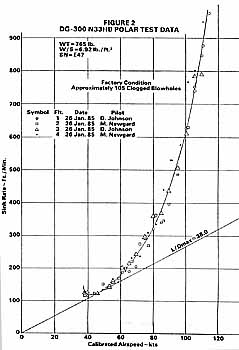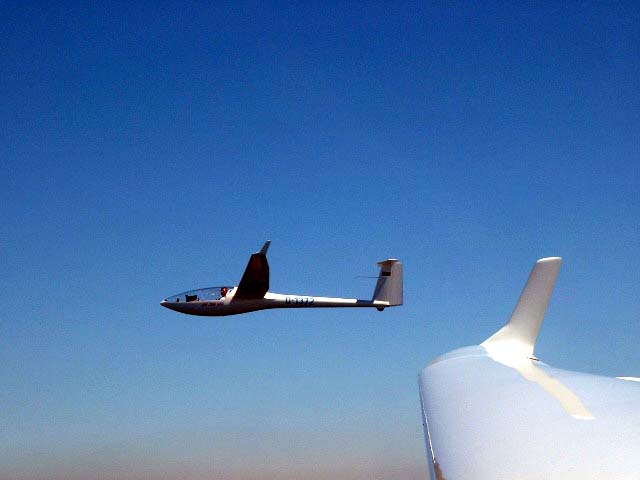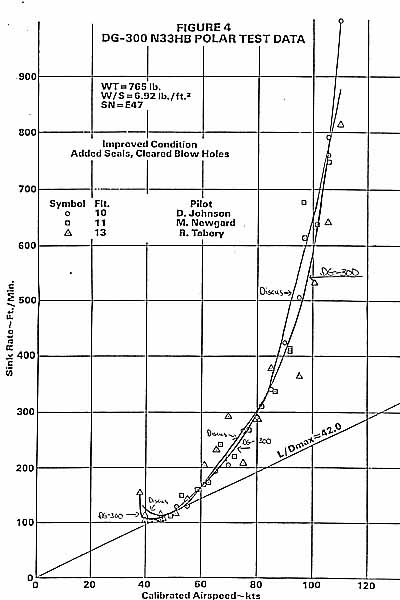DG-303 Elan Standard with Winglets
While the DG-303 Elan with winglets has not yet been thoroughly flight tested in the USA, its predecessor, the DG-300 Standard has been performance tested and documented.
Enclosed is a flight test evaluation of the first generation, DG-300, non-wingleted version, showing an excellent L/D of 42/1, a minimum sink rate of 106 feet per minute and an unballasted sink rate, at 80 knots, of 295 feet per minute.
With a number of changes to the 2nd generation DG-303, including winglets for an L/D of 44/l, an air foil change to the bottom of the wing for better high speed performance and a redesigned canopy, a performance increase of 4-5% has been shown in preliminary testing in the USA.
Further flight test evaluations of the DG-303 Elan/Winglets is to follow.
The following is the Richard Johnson flight test evaluation of the 1st generation DG-300, the predecessor to the current DG-303 Elan with winglets.
A Flight Test Evaluation of the DG-300
The DG-300 is the third series of modern fiberglass sailplanes designed principally by Wilhelm Dirks, a very talented young German designer with a keen interest in sailplane development. He and fellow enthusiast Gerhard Glaser manage Glaser-Dirks Flugzeugbau in Bruchsal, West Germany, which in turn has a licensing/manufacturing agreement with the Elan company of northern Yugoslavia, and this firm fabricates both the DG-101 and the DG-300 series. Their workmanship appears to be excellent in all regards, and they can be proud of their finely crafted sailplanes.
When Travis and Holly Bailey of San Antonio, Texas, received their new DG-300 last winter, they generously offered it for flight testing. Travis was a WW II glider, B-25 and P-38 pilot, and he personally delivered the sailplane to our Caddo Mills, Texas, test site. An outline and factory technical data tabulation of the DG-300 are published. Note the unique tail fin water ballast tank that is used to counter the nose heaviness created by filling the two large wing leading edge water ballast tanks.
Our test sailplane came equipped with optional large sized water ballast bags of 25 gallons (95 L) in each wing panel plus the 1.5-gallon (5.5 L) tail fin tank. Standard sized wing water ballast bags are rated at 17 gallons (65L) each, and that provides about 280 pounds of ballast compared to the 430 pounds with the optional large bags. Because of cold weather and time limitation problems, we did not perform any flight tests with water ballast installed. We did, however, measure the capacity of each wing bag and found that we could load about 23.5 (89L) gallons in the right wing and 22.8 gallons (86L) in the left. These ballast bags are filled through wing bottom surface dump ports, and we may not have gotten all the air out during the filling process. It is quite possible that a more experienced person could install the full 25 gallons per wing rated capacity. Dumping took a reasonable three minutes or so during our ground test.
 The air was relatively still during the first day of our performance testing, and we were able to make four high tows to measure the DG-300’s sink rates at various steady airspeeds. Mike Newgard and I each made a morning and an afternoon test flight, and those test data are shown. A well shaped polar is shown there with no drag knees indicated by those data. A minimum sink rate of about 119 feet per minute (.60 M/s) at 42 knots airspeed and an L/DMax of about 38 at 47 knots are shown by this initial test data.
The air was relatively still during the first day of our performance testing, and we were able to make four high tows to measure the DG-300’s sink rates at various steady airspeeds. Mike Newgard and I each made a morning and an afternoon test flight, and those test data are shown. A well shaped polar is shown there with no drag knees indicated by those data. A minimum sink rate of about 119 feet per minute (.60 M/s) at 42 knots airspeed and an L/DMax of about 38 at 47 knots are shown by this initial test data.
With parachute I weighed close to the DG-300’s minimum allowable cockpit loading of 176 pounds (80 kg). Therefore my test data were taken while flying at near aft c/g limit. On the other hand, Mike’s 60 pounds’ greater weight placed the c/g close to forward limit. Data from the heavier flight were corrected by the square-root-of-the-weight-ratio method to my lighter flight gross weight. Note that the flight test sink rate data taken at forward c/g location (Mike’s flights 2 and 4) compare very well to those at aft c/g condition (my flights 1 and 3). Only during Mike’s last flight, and at airspeeds above 85 knots, did his measured sink rates slightly exceed mine. That last tow was made during the middle of the afternoon, and it is quite possible that he encountered some wing leading edge insect contamination (bugs) during his tow up through the convective surface layer.
The 38-to-1 measured maximum glide ratio was about 10 per cent below that which the manufacturer claimed, and we looked for reasons for that discrepancy. The DG-300 wing lower surfaces are equipped with a single .55-inch (14 mm) inlet diameter ram air source pitot at about mid-span on each wing panel, near the aileron root leading edges. These pitot inlets lead to a single span wise duct located inside each wing at about two-thirds chord aft of the leading edge, and running nearly the full length of each wing panel. About 900 hypodermic needle tubes of .024 inch diameter (0.6 mm) installed through the bottom wing surface provide a path for the pitot pressurized duct air to blow very gently through flush outlets into the wing lower surface boundary layer. The theory is that the wing lower surface laminar flow needs to be forced into transition to normal turbulent flow at that chord wise point, and the small holes can do that with minimum drag losses.

Two test flights were made to test that theory, using the wing drag monitor probe. The first flight measured the DG-300 wing profile drag with the blow hole system functioning normally, and the second with the inlet pitot sources taped shut, thus cutting off the supply of pressurized air to the blowholes. The wing section profile drag vs. airspeed values measured during those two flights showed significantly: About one knot less indicated wing drag is shown at all airspeeds below 80 knots with the boundary layer control system operating. Above that airspeed the blow hole air appeared to have little effect on drag, and that is in agreement with wind tunnel data that indicates laminar separation bubbles are not a problem at the higher airspeeds (Reynolds number effect).

Of the 900-odd blow holes, we counted 105 as being partially or fully clogged. Most were toward the tips, and only one was found clogged near drag probe test locations. We then cleared the clogged holes with a small piece of fine wire and repeated the punk test until all holes were cleared.
The cold air at our winter test altitudes had caused the canopy to shrink slightly during flight, allowing some air leakage at its aft joint near the wing root leading edge. Light insulation stripping (open cell foam) was installed along the canopy frame edges, and additional sealing of the under-seat tow release was accomplished before we began a second phase of performance testing.
Three additional high tow test flights were then made to re-test the DG-300 in its improved condition with the added seals and cleared flow holes. It showed, that the data from those flights indicates a significant increase in performance. A minimum sink rate of about 106 feet per minute (0.54 M/s) is now shown at 42 knots, and a splendid L/DMax of about 42 at 48 knots was measured. No high drag knees are indicated by the test data, and the polar appears to have a smooth classical shape.

The airspeed system uses a fuselage nose pitot that is located inside the nose air vent inlet. Left and right side static vents are located on the lower fuselage nose, about 14.3 inches (360 mm) aft of the tip. A high tow was made by Mike to measure the DG-300 airspeed system error. Surprisingly little error is shown, considering that fuselage nose static sources generally are not noted for accuracy. About + 2 knots error was shown in the 40 to 50 knot region, but at higher airspeeds the airspeed system errors approached a perfect zero!

The stall characteristics appear to be gentle, from both straight and turning flight conditions. There was no tendency to drop a wing during stall, and recovery was quick and positive in all cases. However, as with practically all modern sailplanes, almost no buffeting precedes a stall, only quietness and low responses to control inputs. The air brakes are relatively large Schempp-Hirth type top surface only devices that function well and cause a slight nose-down pitch change when opened. They are powerful enough to permit steep approaches when needed yet are easily operated from the cockpit.
As with the DG-101, the tow hook is located on the bottom of the fuselage, only about three inches (76 mm) ahead of the main landing wheel. Because of that low and far-aft tow hook location, the DG-300 tends to pitch nose-up during aero tow takeoffs, at least when flown at aft c/g as I flew it. Mike said it was not very noticeable with his more forward c/g. To counter nose-up pitch, the handbook recommends initiating takeoff with the trim set to full nose-down, and that worked fairly well for me. The single tow hook is intended for both winch and aero tow launches, but it does not provide very satisfactory characteristics for aero towing because the low aft hook location causes an unwanted nose-up pitch that is proportional to towline tension. Hopefully a fuselage nose aero tow hook will be made available, and that should make aero towing much easier and safer, especially for pilots of limited experience.
The thermalling characteristics of our test DG-300 appeared to be good, but not outstanding in our relatively weak winter thermals. Rolls from 45° to 45° could be performed in about 4.0 seconds when flying at 50 knots thermalling airspeed. Level flight stall speed was about 37 knots calibrated and indicated at my unballasted 765 pounds (347 kg) gross weight. That airspeed corresponds to a maximum lift coefficient of 1.50, which is quite good for an unflapped sailplane.

Thanks go to Holly and Travis Bailey for loaning their splendid new DG-300 for testing, and to Oliver Dyer-Bonnet, Mike Newgard and Ron Tabery who assisted with the flight testing. Also to Oliver and the Dallas Gliding Association who provided towing funds.
Polar of the DG-300 vs. Discus
Brief description and three dimensional side view of the DG-303
Technical Data and Cockpit of the DG-303
We received the following message in our Guest book:
From / Von: Bob Davis
A few notes since receiving my DG-303 at the end of this past August. -The plane arrived at the docks in Ventura, CA in perfect condition. -The finish on it is the nicest of any plane at Minden. -The performance of the plane w/winglets is better than either Discus A or B that I was flying before receiving my 303. -I have been able to put 60 hrs in the plane this fall at Minden over a five week period and it has all been a joy. -I was able to do a side by side flight for a little over an hour with a new DG-800B (Pete Kelly). We flew at various speeds and configurations (Thermal, Slow, Fast, Gear Up, Gear Down) and at all but the slowest speed there was no difference in performance! This plane is a winner for me. Bob Davis 303BD “GO”

